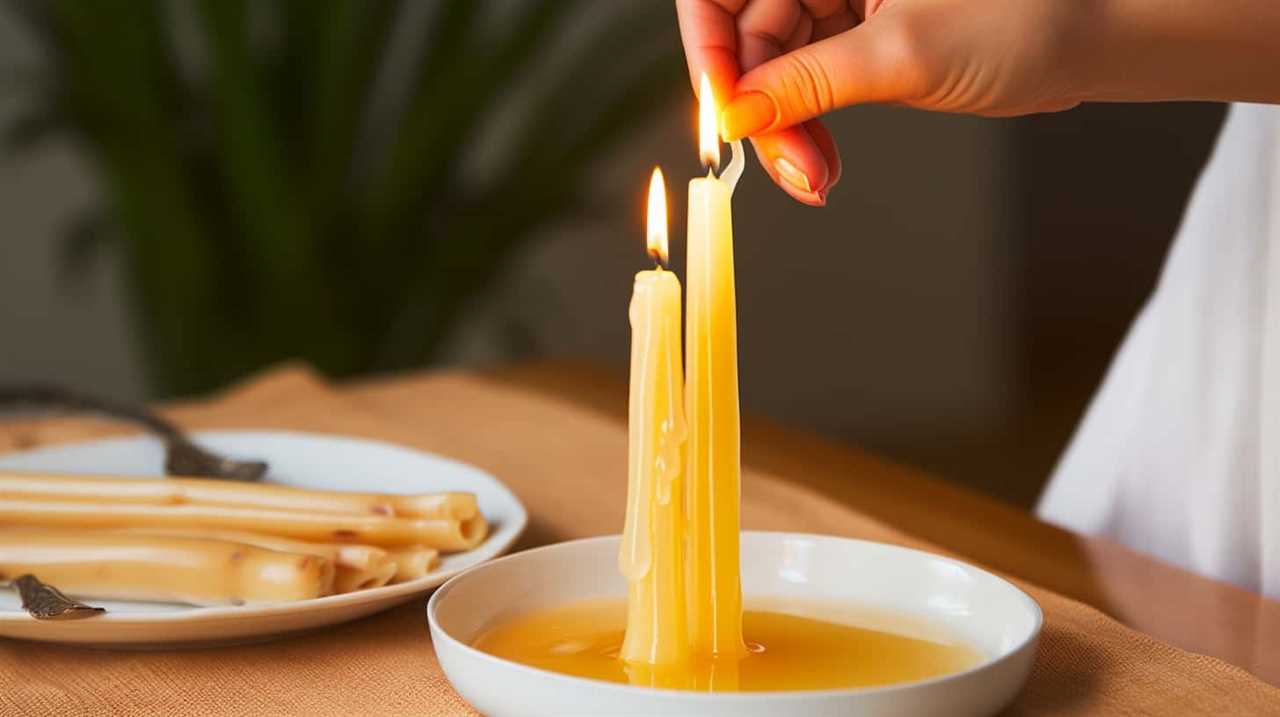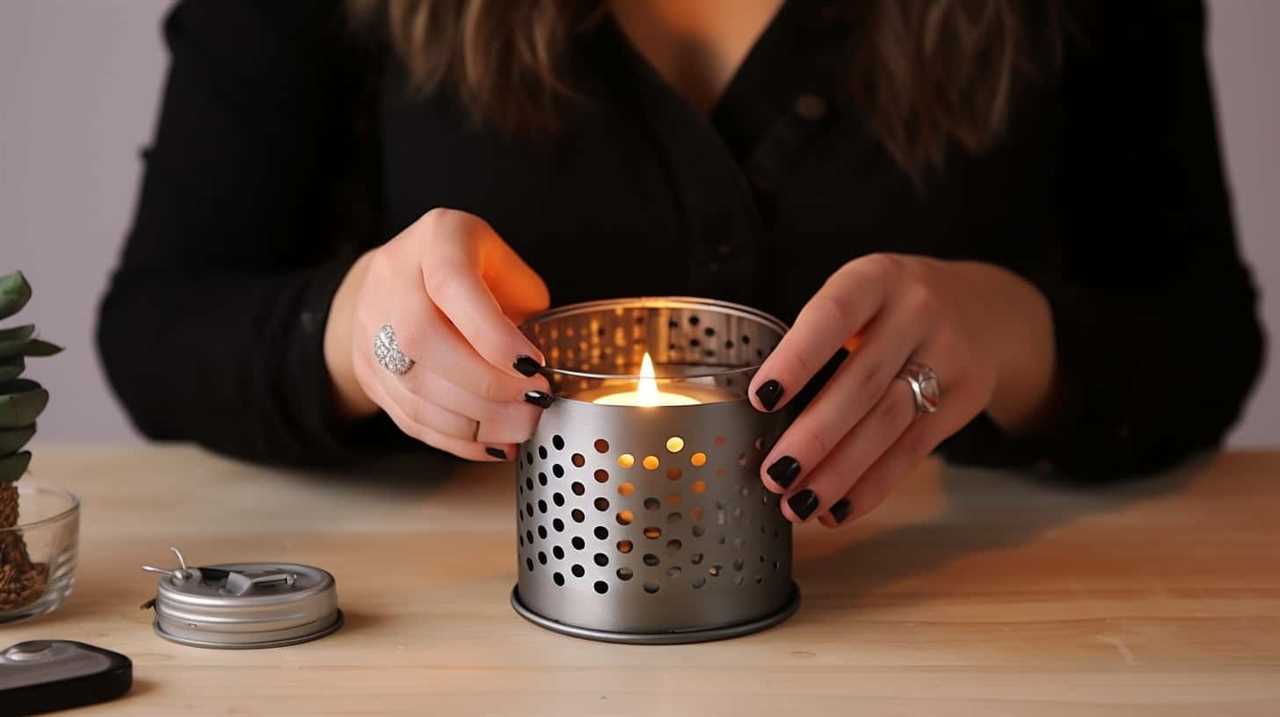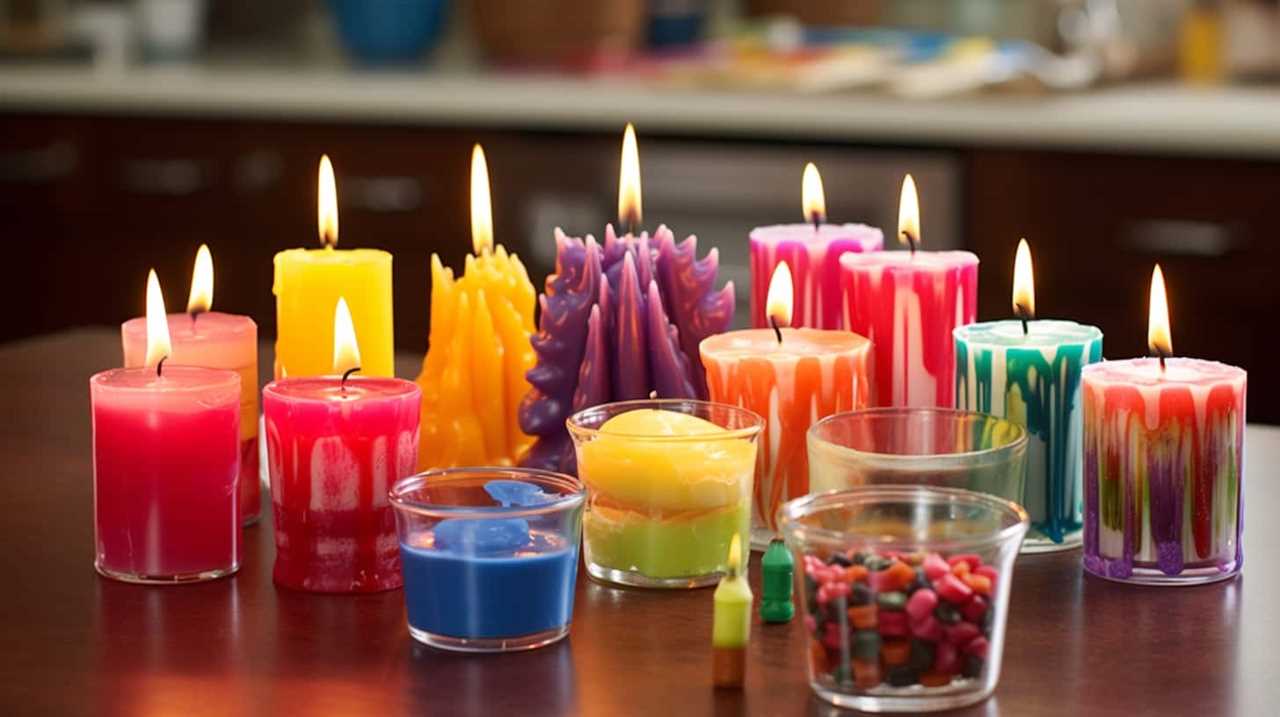When it comes to getting rid of candle wax on carpets and furniture, most people believe that where there’s a will, there’s a way. Our aim is to assist you in discovering that solution!
In this guide, we’ll share some simple and effective methods to help you tackle those stubborn wax stains. Whether you accidentally spilled wax on your favorite carpet or your cozy upholstery, don’t worry – we’ve got you covered!
With a few basic supplies and a little bit of patience, you’ll be able to restore your carpet and upholstery to their former glory. So let’s roll up our sleeves and get started on this wax-removal adventure together!
Key Takeaways
- Scraping off excess wax can be done using a butter knife or spoon, ice cubes, a brown paper bag or white cloth, and a vacuum cleaner for clean-up.
- The heat and blot method involves using a hairdryer or iron to heat the wax, then blotting it with a paper towel or cloth to absorb the melted wax.
- The freeze and scrape method requires freezing the wax with ice cubes, then scraping it off with a plastic scraper or blunt object.
- The iron and paper method involves using a low-heat iron and placing a piece of white paper or paper towel over the wax to melt and absorb it.
Gather Necessary Supplies
First, we gather the necessary supplies to remove candle wax from carpet and upholstery. When it comes to removing candle wax, having the right tools is essential. The first item you’ll need is a butter knife or a spoon to scrape off any excess wax from the surface. This will help prevent further damage to the fabric.

Next, you’ll need a brown paper bag or a plain white cloth. These materials will be used to absorb the melted wax. Additionally, you’ll need an iron and a clean towel. The iron will be used to heat up the wax, making it easier to remove. If you prefer a DIY approach, you can use ice cubes instead of an iron. Simply place the ice cubes on top of the wax to harden it, then scrape it off.
Now that we’ve gathered the necessary supplies, let’s move on to the next step: scraping off the excess wax.
Scrape off Excess Wax
Now that we’ve gathered the necessary supplies, it’s time to tackle the next step in removing candle wax from carpet and upholstery: scraping off excess wax.
There are several effective methods to accomplish this.

One option is to heat the wax with a hairdryer or iron and then blot it up with a paper towel.
Another method involves freezing the wax with ice or a freezer pack, and then gently scraping it off with a plastic scraper.
Lastly, you can place a paper towel or brown paper bag over the wax and use a warm iron to melt and transfer the wax onto the paper.
Heat and Blot
To begin removing candle wax from carpet and upholstery, we’ll start by applying heat to the wax and then blotting and scraping off the excess wax.

Heat is an effective method for loosening the wax and making it easier to remove. You can use a hairdryer on its lowest heat setting or an iron on a low heat setting with a cloth between the iron and the wax. Gently heat the wax until it begins to melt.
While the wax is still warm, place a clean cloth or paper towel over the area and press down firmly to absorb the melted wax. Repeat this process with a fresh cloth until no more wax transfers onto the cloth.
After blotting, use a plastic scraper or a butter knife to scrape off any remaining hardened wax. Take care not to damage the carpet or upholstery fibers.
Once you have removed as much wax as possible, proceed to the next step in the cleaning process.

Freeze and Scrape
Once the excess wax has been heated and blotted, it’s time to move on to the next step: freezing and scraping off any remaining wax.
Freezing the wax helps harden it, making it easier to scrape off. To do this, place a few ice cubes in a plastic bag and press it against the wax stain. Leave it there for about 10 minutes, allowing the wax to freeze and become brittle.
Once the wax is frozen, take a blunt object, like a butter knife or credit card, and gently scrape off the wax in small, controlled motions. Be careful not to damage the carpet or upholstery fibers. Continue scraping until all the wax is removed.
Now that the excess wax has been successfully removed, let’s move on to the next step: using an iron and paper to remove any remaining stains.

Use Iron and Paper
We can use an iron and paper to scrape off any excess wax from the carpet or upholstery. This iron and paper technique is a simple and effective way to remove stubborn wax stains. Here’s how it works:
| Iron and Paper Technique |
|---|
| Materials Needed: |
| – Iron |
| – White paper or paper towel |
| Instructions: |
| 1. Set the iron to a low heat setting without steam. |
| 2. Place a piece of white paper or paper towel over the wax stain. |
| 3. Gently press the iron onto the paper, moving it in a circular motion. |
| 4. The heat from the iron will melt the wax, and the paper will absorb it. |
| 5. Continue this process until no more wax transfers onto the paper. |
Using an iron and paper is just one of the alternative wax removal methods. However, if you prefer a different approach, you can try the next method – the use of a paper bag and iron.
Use a Paper Bag and Iron Method
How can we effectively remove candle wax from carpet and upholstery using the paper bag and iron method? This method is a simple and efficient way to tackle wax spills on fabrics without causing any damage.
To successfully remove the wax, follow these steps:

- Place a brown paper bag or a plain white paper towel over the wax stain.
- Set the iron on a low heat setting and gently iron over the paper bag.
- As you iron, the wax will start to melt and transfer onto the paper bag.
- Move the paper bag around to a clean area, exposing a fresh part to the stain.
- Continue ironing and transferring the wax until no more wax is being absorbed by the bag.
- Once the wax is removed, use a mild detergent and warm water to clean the remaining residue.
- Blot the area dry with a clean cloth.
Apply Ice or Freeze the Wax
Now, let’s talk about how to apply ice or freeze the wax to remove it from your carpet or upholstery.
Freezing the wax is a common method used to make it easier to remove from fabrics. By applying ice or a cold pack to the wax, it hardens and becomes less sticky, allowing you to scrape it off more easily.
This technique can be quite effective in removing wax stains, but it’s important to use the proper techniques to avoid damaging your carpet or upholstery.
Freezing Wax for Removal
To facilitate the removal of candle wax from carpet and upholstery, it’s important to first freeze the wax by applying ice or placing the affected area in a freezer. Freezing the wax helps to harden it, making it easier to scrape off or break apart.

Here are some freezing wax alternatives and tips for preventing wax spills:
- Use ice cubes: Place ice cubes in a plastic bag and apply it directly to the wax. The cold temperature will cause the wax to solidify and shrink, making it easier to remove.
- Freeze the affected area: If the wax spill is on a larger surface like a carpet or upholstery, you can place the entire area in a freezer. This will freeze the wax and make it brittle, allowing you to break it apart and remove it more effectively.
- Preventing wax spills: To avoid wax spills in the first place, consider using dripless candles or placing a protective barrier like a tray or aluminum foil underneath the candle. Additionally, keeping candles away from drafts or air vents can help prevent wax from splattering.
Ice Method Effectiveness
We found that using ice to freeze the wax is a highly effective method for removing candle wax from carpet and upholstery. The ice method works by applying ice directly onto the wax, causing it to harden and become brittle. Once the wax is frozen, it can be easily scraped off with a blunt object, such as a butter knife or credit card. This technique is particularly useful for larger candle wax spills or when dealing with delicate fabrics that may be damaged by heat.
However, it’s important to note that the ice method does have some drawbacks. For instance, it may not work as effectively on deeply embedded wax or colored candles, as these can leave behind stains. In such cases, alternative wax removal techniques, such as using a hairdryer or applying a solvent, may be necessary.
Wax Removal Techniques
For removing candle wax from carpet and upholstery, one effective technique is to apply ice or freeze the wax. This method is particularly useful when dealing with larger or thicker wax stains. By freezing the wax, it becomes brittle and easier to remove without causing damage to the carpet or upholstery.

Here are three sub-lists of wax removal alternatives using natural wax cleaning methods:
- Ice cubes: Place ice cubes in a plastic bag and apply it directly to the wax stain. Leave it there until the wax hardens, usually around 15-20 minutes. Once the wax is frozen, gently scrape it off with a butter knife or a credit card. Be careful not to scrape too hard to avoid damaging the fabric.
- Freeze spray: Alternatively, you can use a freeze spray specifically designed for removing wax stains. Follow the instructions on the product and spray it directly on the wax. Allow it to freeze and then scrape it off as mentioned above.
- Freezer method: If the affected carpet or upholstery can be moved, you can place it in the freezer for a few hours. This will freeze the wax, making it easier to remove. After taking it out of the freezer, gently scrape off the frozen wax.
Use a Carpet Cleaner or Upholstery Cleaner
After the candle wax has been scraped off, it is important to use a carpet cleaner or upholstery cleaner to effectively remove any remaining residue. These cleaning solutions are specifically designed to tackle tough stains and grime on carpets and upholstery. They come in various formulations and options, each with its own set of benefits and features. To help you make an informed decision, here is a table highlighting the effectiveness of different carpet cleaners and upholstery cleaner options:
| Carpet Cleaner | Upholstery Cleaner |
|---|---|
| Foam-based | Spray-on |
| Liquid-based | Dry powder |
| Enzyme-based | Solvent-based |
| Natural/eco-friendly | Steam cleaner |
| Dual-action | Fabric-safe |
Each cleaner has its own unique advantages and may be more suitable for certain types of stains or materials. It is essential to read the instructions carefully and choose the appropriate cleaner for your specific needs. Once you have selected the right cleaner, follow the instructions for application and removal. After using the cleaner, transition into the next step of the process: blotting the area with a towel.
Blot the Area With a Towel
To ensure thorough removal of any remaining residue, we recommend gently blotting the area with a towel after using a carpet cleaner or upholstery cleaner. Blotting is an important step because it helps to absorb any excess moisture and leftover wax that may still be present.

Here are some helpful tips for effective blotting:
- Use absorbent materials for blotting such as white cotton towels or paper towels. These materials will help to soak up the wax without spreading it further.
- Press down on the stained area with the towel and apply gentle pressure. Avoid rubbing or scrubbing, as this can push the wax deeper into the carpet or upholstery fibers.
- If the towel becomes saturated with wax, replace it with a fresh one to continue blotting.
If you prefer alternative methods for removing wax stains, you can try using a hairdryer to melt the wax and then blot it up with a towel. Another option is placing a brown paper bag over the wax stain and ironing over it with a low heat setting, allowing the wax to transfer onto the paper bag.
After blotting the area, it’s time to move on to the next step: vacuum or brush the surface to remove any residue. This will ensure a clean and fresh finish to your carpet or upholstery.
Vacuum or Brush the Surface to Remove Any Residue
To effectively remove any residue, we will now vacuum or brush the surface. Vacuum cleaning and brush techniques are crucial in ensuring that no wax particles are left behind on the carpet or upholstery. The vacuum cleaner will help to suck up any loose wax while the brush will agitate the fibers and dislodge any stubborn residue. Here is a table to give you a visual representation of the process:

| Step | Vacuum Cleaning | Brush Techniques |
|---|---|---|
| 1 | Use a vacuum cleaner with a nozzle attachment to remove loose wax particles. Make sure to cover the entire affected area. | Gently brush the surface in a circular motion to loosen any remaining wax residue. Be careful not to damage the fibers. |
| 2 | Repeat the vacuuming process if necessary to ensure all wax particles are removed. | Continue brushing until all residue is gone. |
| 3 | Empty the vacuum cleaner bag or canister to prevent the wax from spreading to other areas. | Clean the brush thoroughly after use to remove any wax residue. |
Frequently Asked Questions
Can I Use a Hairdryer to Remove Candle Wax From Carpet or Upholstery?
We can use a hairdryer to remove candle wax from carpet or upholstery. By applying heat to the wax, it will melt and can be easily wiped away. However, caution should be taken to avoid spreading the wax or causing damage.
Will Using a Knife or Sharp Object Damage the Carpet or Upholstery?
Using a knife or sharp object to remove candle wax from carpet or upholstery may cause damage. Instead, try alternative methods like using ice to harden the wax and gently scraping it off.
Can I Use a Plastic Bag Instead of a Paper Bag for the Iron Method?
Yes, using a plastic bag instead of a paper bag can be an alternative method for removing candle wax from carpet or upholstery. It provides a similar effect as the iron method, but be cautious not to melt the plastic bag.
How Long Should I Leave the Ice or Frozen Wax on the Carpet or Upholstery?
To determine how long to freeze wax, we recommend leaving the ice or frozen wax on the carpet or upholstery for at least 15-20 minutes. However, there are alternative methods for removing wax that may be more effective.

Is It Necessary to Use a Carpet or Upholstery Cleaner After Removing the Wax?
Yes, it is necessary to use a carpet or upholstery cleaner after removing the wax. This ensures that any residue or stains left behind by the wax are fully removed, leaving your carpet or upholstery looking clean and fresh.
Conclusion
In just a few simple steps, you can easily remove candle wax from your carpet or upholstery. With the right supplies and techniques, like using an iron and paper bag or applying ice, you can say goodbye to those stubborn wax stains.
Remember to always blot and vacuum to ensure a clean and residue-free surface. Don’t let candle wax ruin the beauty of your home, tackle it head-on and restore your carpet and upholstery to their former glory.










